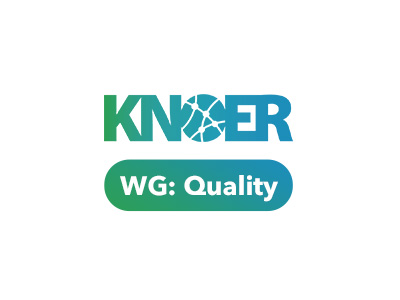Quality criteria for open educational resources (OER) have so far been used by initiatives at universities largely independently of one another. Following intensive discussions in the specialist community, five OER state initiatives from the higher education sector in Germany have now agreed on a common understanding of quality in a working group. The working group on OER quality was initiated by the Working Group on Digitization of the Standing Conference of the Ministers of Education and Cultural Affairs of the Länder and is now linked to the Cooperation Network OER-promoting Infrastructures and Services (KNOER).
Cross-national understanding
Since its inception, the working group has grown steadily. It now includes representatives from five OER state initiatives (HOOU, vhb, ORCA.nrw, twillo, ZOERR) as well as other experts, e.g. from the European University for Innovation and Perspectives and the University of Bremen. Each OER state initiative sets its own priorities in terms of content, but has a comparable understanding of quality assurance. As part of a status quo analysis within the working group, it quickly became clear that comparable goals have already been pursued more or less independently of each other with regard to the quality of the open educational resources published via the OER state initiatives. Almost all state initiatives are based on the Mayrberger and Zawacki-Richter quality model, which was commissioned from the Hamburg Open Online University (HOOU). “It was a perfect basis on which to define and refine the common quality criteria,” says Dr. Wiebke Breustedt, Quality Manager at ORCA.nrw.
For the members of the OER quality working group, it is clear that quality criteria for OER can basically be divided into two dimensions. The pedagogical-didactic dimension deals with the question of when the content of OER is good. On the one hand, the scientific foundation – i.e. the correct reproduction of content, citations, etc. – plays an important role, and on the other hand, the reusability of the content of the materials. OER should therefore be made freely available in a self-contained manner and at the same time offer the possibility of removing and (re)using individual content. There is also the didactic component: The learning objective of the free educational resource should be clear and match the content. Alignment is the keyword here.
The technical dimension also plays a decisive role in the quality criteria. It ensures the accessibility of the materials. On the one hand, open licensing in accordance with the UNESCO OER definition is important here. This allows OER to be used, modified and passed on to third parties. On the other hand, technical reusability must be ensured so that teaching/learning materials can be easily integrated into various applications. This is particularly easy if open source software is used in the creation process.
Goal: More quality and transparency
For the state initiatives, the agreement on quality criteria contributes to the high quality of open educational resources and provides orientation for authors and users of OER. Nina Anders, Quality Manager for the HOOU, puts it this way: “Teachers and students should be able to rely on the quality of open educational resources, regardless of which state portal they use. It is therefore important to us that the quality of OER available via different state portals is comparable.“ The shared understanding of quality among the state initiatives is a major milestone in this regard.
The state initiatives also want to use the common set of quality criteria in the future. As part of KNOER, so-called KNOER collections are planned, which will be created from OER materials from the respective state initiatives on various topics.
Support services
In order to provide authors of free educational resources with the best possible support in implementing the quality criteria, the OER state initiatives offer numerous services.
Self-checks & FAQs
Using the FAQs, authors can obtain information from the state initiatives about the quality assurance of their OER and check the quality with the help of self-checks:
– Twillo quality quick check: In seven steps, authors can check their OER for all relevant criteria before publication and then share or revise them in a targeted manner with a clear conscience.
– HOOU H5P self-check: The four HOOU mandatory criteria are prepared as an H5P self-check for your own review.
– ORCA.nrw checklist “Creating OER”: The ten-page document serves as a guide for checking the quality criteria and contains a practical list of checkboxes.
– FAQ: The extensive FAQ sections of ZOERR, twillo, vhb and ORCA.nrw provide clear information on the topics of OER creation, publication, license selection and the special features of the respective state initiatives.
Legal information
OER can be reproduced, used, processed, mixed and distributed in many ways. To answer legal questions on copyright, data protection and examination law, for example, the state initiatives offer a range of complementary contact points and tools. At ORCA.nrw, for example, this is the legal information office, while at twillo it is the legal issues competence area. The HOOU offers the Rechtslotsen tool for finding out about legal aspects. In addition, the Multimedia Kontor Hamburg (MMKH) provides a cross-university legal information office as part of the HOOU, which also operates the “HOOU-Rights” blog on copyright issues and CC licenses.
Personal advice, workshops & events
The state initiatives also offer personal advice, editorial support and a variety of workshops and other events on issues relating to OER. Further information can be found on the websites of the state initiatives:
HOOU ORCA.nrw twillo vhb ZOERR
Contact
Coordinators of the AG:
Dr. Marc Göcks MMKH/HOOU (m.goecks@mmkh.de)
Dr. Klaus Wannemacher HIS-HE/twillo (wannemacher@his-he.de)
